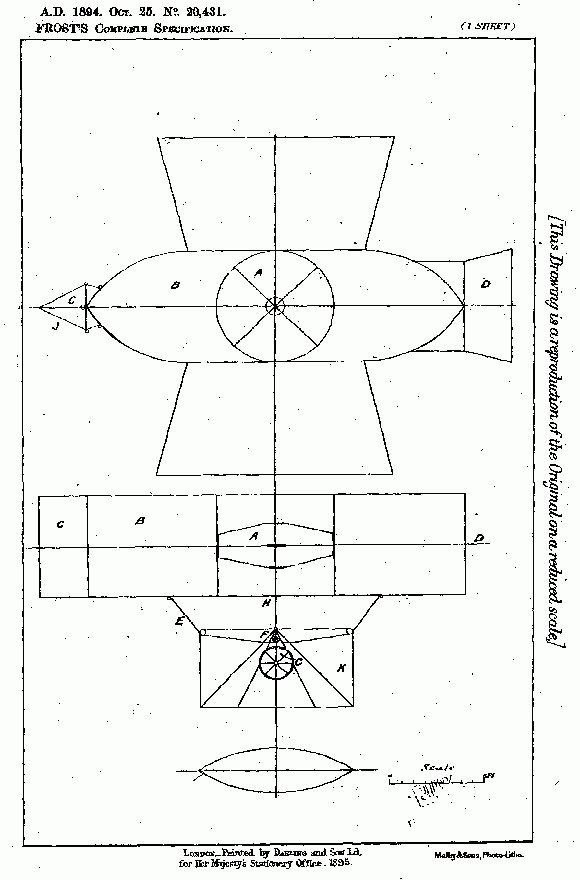Bill Frost on:
[Wikipedia]
[Google]
[Amazon]
William Frost (28 May 1848 – March 1935) was a 
"A Pembrokeshire Pioneer Welsh Wizard Prang"
in ''The Spectator''. Retrieved 15 July 2014 Frost reportedly made a flight at Saundersfoot on or about 24 September 1896 for a distance of about 500 metres, then crashed into bushes (by comparison, the first powered flight of the Wright brothers traveled 120 feet in 12 seconds). During the night following the flight, a violent storm destroyed and scattered the flying machine. The event was not recorded except in local memories. Although a poor working man, Frost applied for a patent which was accepted and registered in London on 25 October 1894 under number 1894-20431. Unable to pay renewal fees, he allowed the patent to lapse four years later. He gave up on the idea of flying, and ripped up all but one sheet about the Frost Flying Machine. He died without wealth or recognition in 1935.
Bill Frost - the first man to fly?
BBC Blogs 2011 {{DEFAULTSORT:Frost, William 1848 births 1935 deaths British aviation pioneers Welsh aviators Welsh inventors People from Pembrokeshire
Welsh
Welsh may refer to:
Related to Wales
* Welsh, referring or related to Wales
* Welsh language, a Brittonic Celtic language spoken in Wales
* Welsh people
People
* Welsh (surname)
* Sometimes used as a synonym for the ancient Britons (Celtic peop ...
designer of an early flying machine, the Frost Airship Glider
The Frost Airship Glider was an aircraft designed and constructed in Wales during the mid-1890s by William (Bill) Frost. According to patent specification 1894-20431, issued in London, the craft was simply called "A Flying Machine".
The preamble ...
.

Biography
William Frost was born on 28 May 1848 in Saundersfoot,Pembrokeshire
Pembrokeshire ( ; cy, Sir Benfro ) is a Local government in Wales#Principal areas, county in the South West Wales, south-west of Wales. It is bordered by Carmarthenshire to the east, Ceredigion to the northeast, and the rest by sea. The count ...
, to Rebecca and John Frost.
His ambition to invent a flying machine started about 1880. Despite his poverty he constructed the "Frost Airship Glider
The Frost Airship Glider was an aircraft designed and constructed in Wales during the mid-1890s by William (Bill) Frost. According to patent specification 1894-20431, issued in London, the craft was simply called "A Flying Machine".
The preamble ...
", which seems, in principle, to have resembled a vertical takeoff
Takeoff is the phase of flight in which an aerospace vehicle leaves the ground and becomes airborne. For aircraft traveling vertically, this is known as liftoff.
For aircraft that take off horizontally, this usually involves starting with a t ...
airplane, with gas-filled tanks. From the patent description:
The flying machine is propelled into the air by two reversible revolving horizontally. When sufficient height is gained, wings are spread and tilted by means of a lever, causing the machine to float onward and downward. When low enough the lever is reversed causing it to rise upward & onward. When required to stop it the wings are tilted so as to hold against the wind or air and lowered by the reversible fans. The steering is done by a helm fitted to front of machine.The patent seems to contradict itself in the next paragraph which says, "The steering is done by a rudder at both ends." The '' Edinburgh Evening News'', reporting on the machine in October 1895, reported: "the inventor confidently predicts that it will travel at the rate of 100 miles an hour". Writer Byron Rogers, apparently relying on the book ''A Pembrokeshire Pioneer'' by Roscoe Howells, gave a description of the flying machine as "part balloon (gas cylinders gave it lift), part powered hang glider, foot-pedals operating helicopter-style blades".
in ''The Spectator''. Retrieved 15 July 2014 Frost reportedly made a flight at Saundersfoot on or about 24 September 1896 for a distance of about 500 metres, then crashed into bushes (by comparison, the first powered flight of the Wright brothers traveled 120 feet in 12 seconds). During the night following the flight, a violent storm destroyed and scattered the flying machine. The event was not recorded except in local memories. Although a poor working man, Frost applied for a patent which was accepted and registered in London on 25 October 1894 under number 1894-20431. Unable to pay renewal fees, he allowed the patent to lapse four years later. He gave up on the idea of flying, and ripped up all but one sheet about the Frost Flying Machine. He died without wealth or recognition in 1935.
Notes
Bibliography
*External links
Bill Frost - the first man to fly?
BBC Blogs 2011 {{DEFAULTSORT:Frost, William 1848 births 1935 deaths British aviation pioneers Welsh aviators Welsh inventors People from Pembrokeshire